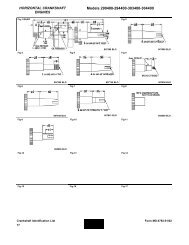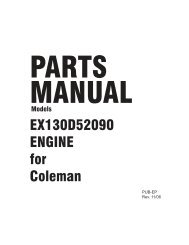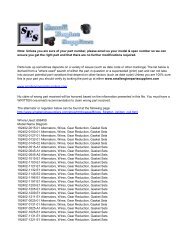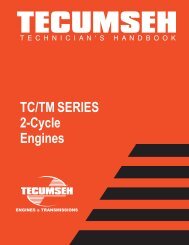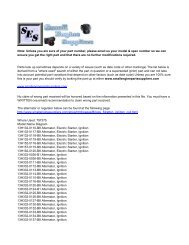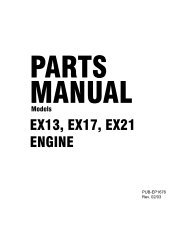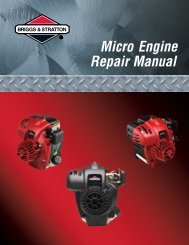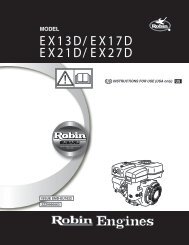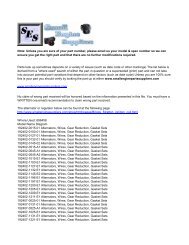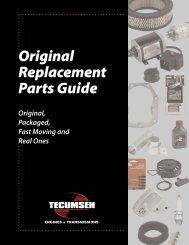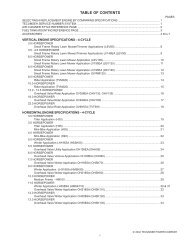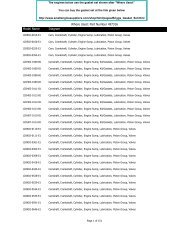3to 11hp 4-cycle l-head engines - Small Engine Suppliers
3to 11hp 4-cycle l-head engines - Small Engine Suppliers
3to 11hp 4-cycle l-head engines - Small Engine Suppliers
You also want an ePaper? Increase the reach of your titles
YUMPU automatically turns print PDFs into web optimized ePapers that Google loves.
NOTE: ON OLDER POINT IGNITION SYSTEMS, THE<br />
A.C. OUTPUT LEADS ARE BLACK AND RED.<br />
3 Amp D.C. Alternator System - Rectifier<br />
Panel<br />
This 3 amp system is readily identified by the rectifier<br />
panel in the circuit. The panel includes two diodes and a<br />
fuse for overload protection. The rectifier panel does not<br />
regulate the output of this system.<br />
CHECKING THE SYSTEM: Check the fuse to determine<br />
if it is good. A continuity light or ohmmeter can detect a<br />
faulty fuse. Replace with a six (6) amp fuse if necessary.<br />
Determine if the diodes are functioning properly. A<br />
continuity light may be used to check diodes. (diag. 17).<br />
GREEN<br />
YELLOW<br />
-<br />
+<br />
YELLOW<br />
17<br />
D.C. VOLTMETER<br />
When replacing the diode in the rectifier panel, locate<br />
the undercut on one end of the diode and match it to the<br />
detent on terminal clip of the rectifier panel.<br />
Test the D.C. output of the rectifier panel as follows:<br />
Disconnect the battery lead from the terminal of rectifier<br />
panel. Use D.C. voltage meter probe on + battery terminal<br />
as shown in the diagram (diag. 18). Connect negative<br />
lead to engine ground.<br />
Minimum values should read:<br />
PROBE<br />
FUSE<br />
RECTIFIER PANEL<br />
MOUNTED ON<br />
ENGINE<br />
+ -<br />
TO ENGINE<br />
GROUND<br />
18<br />
A.C.<br />
VOLTMETER<br />
2500 R.P.M. - 12.0 Volts D.C.<br />
3000 R.P.M. - 14.0 Volts D.C.<br />
3300 R.P.M. - 16.0 Volts D.C.<br />
3600 R.P.M. - 18.0 Volts D.C.<br />
FUSE<br />
If these minimum readings are noted, the system is okay.<br />
Check for bad battery, ammeter, wiring, etc.<br />
If less than above reading, proceed to make an A.C. output<br />
check. With the battery lead disconnected from rectifier<br />
panel, probe the A.C. terminals with the voltmeter on the<br />
A.C. scale (diag. 19).<br />
19<br />
Minimum values should read:<br />
2500 R.P.M. - 24.0 Volts A.C.<br />
3000 R.P.M. - 29.0 Volts A.C.<br />
3300 R.P.M. - 32.0 Volts A.C.<br />
3600 R.P.M. - 35.0 Volts A.C.<br />
If less than above output, generating coil assembly is<br />
defective. See Chapter 9 for "Disassembly Procedure".<br />
NOTE: There is no regulator in this system. The total<br />
output of the two diodes is three (3) AMPS. If the battery<br />
is overcharging (boiling and bubbling), reduce the D.C.<br />
input by one-half by removing one of the diodes.<br />
51



